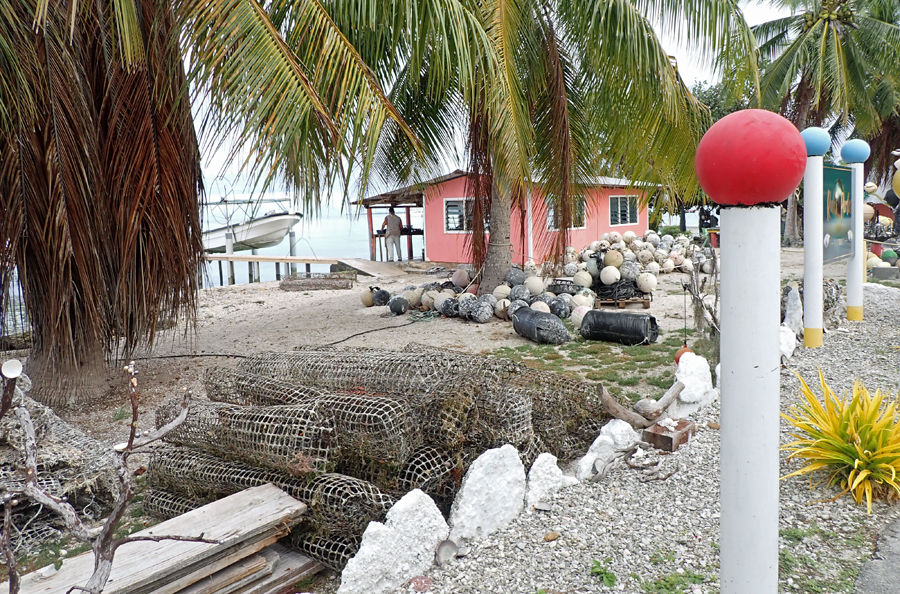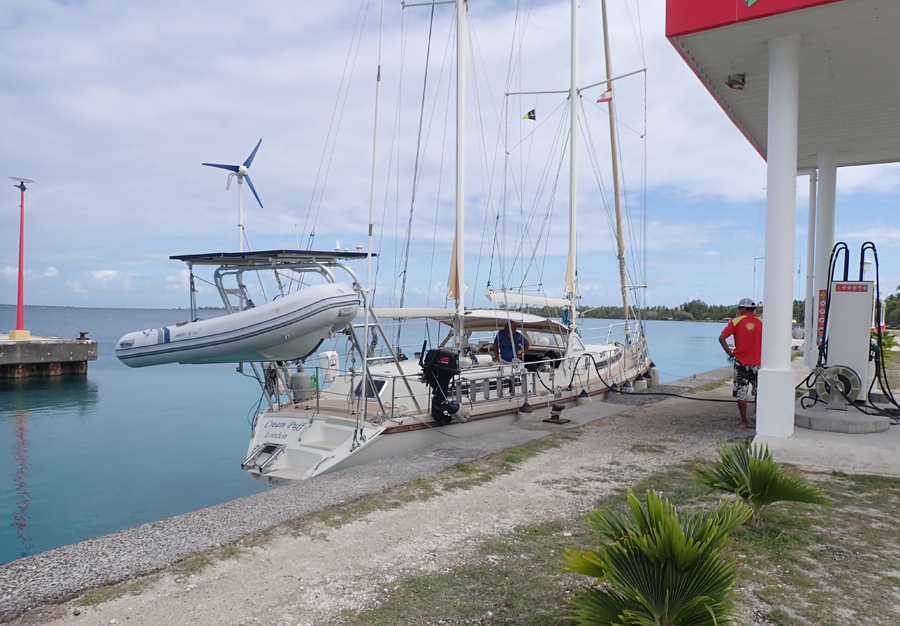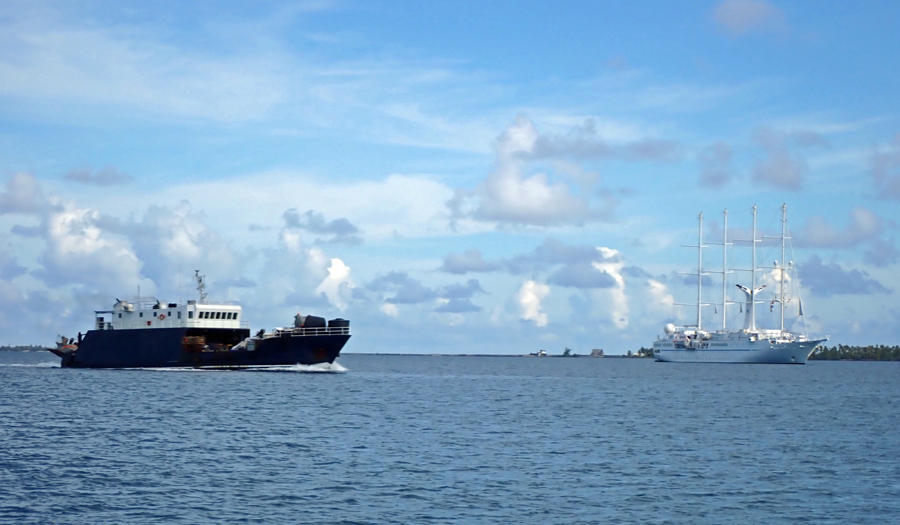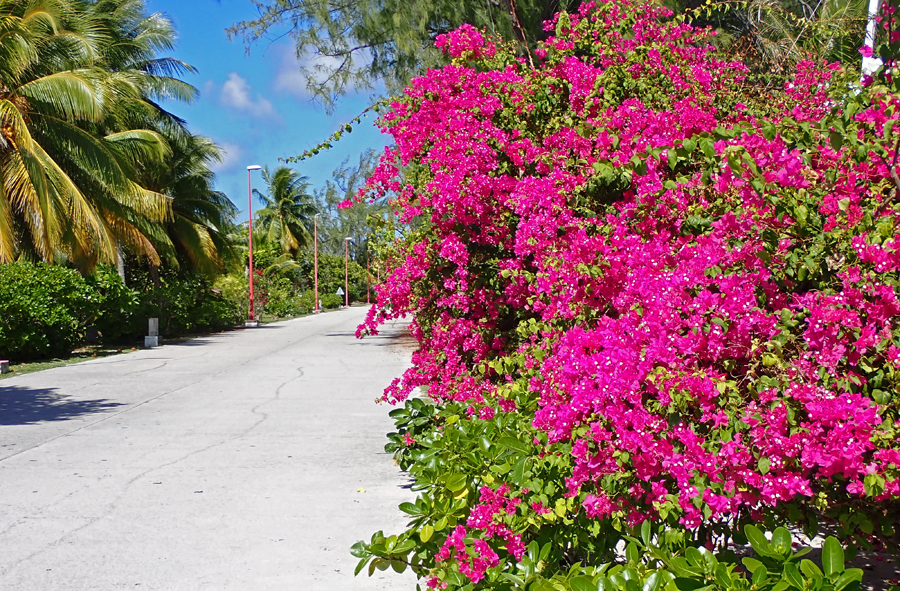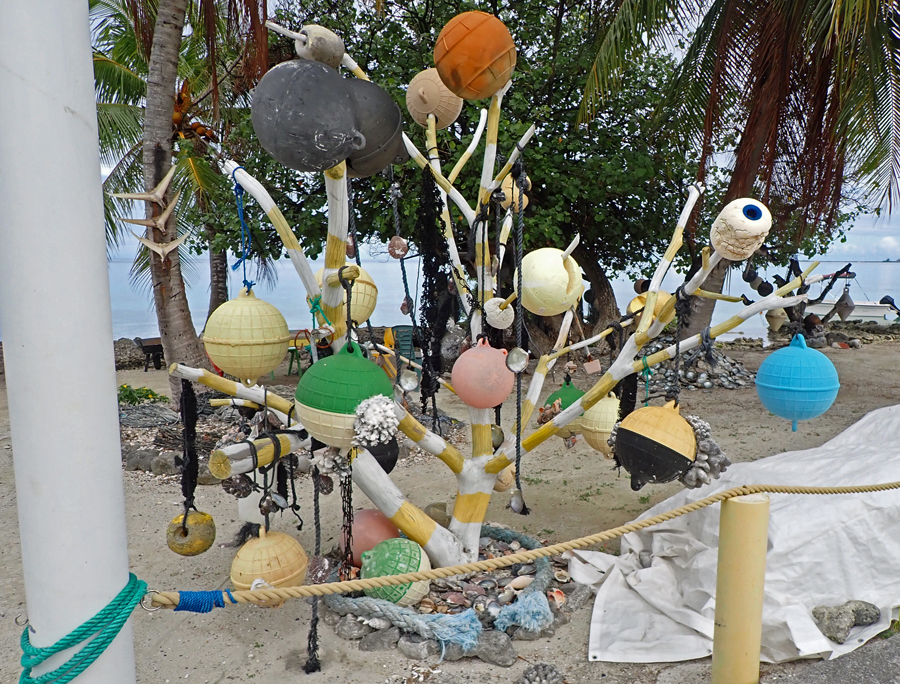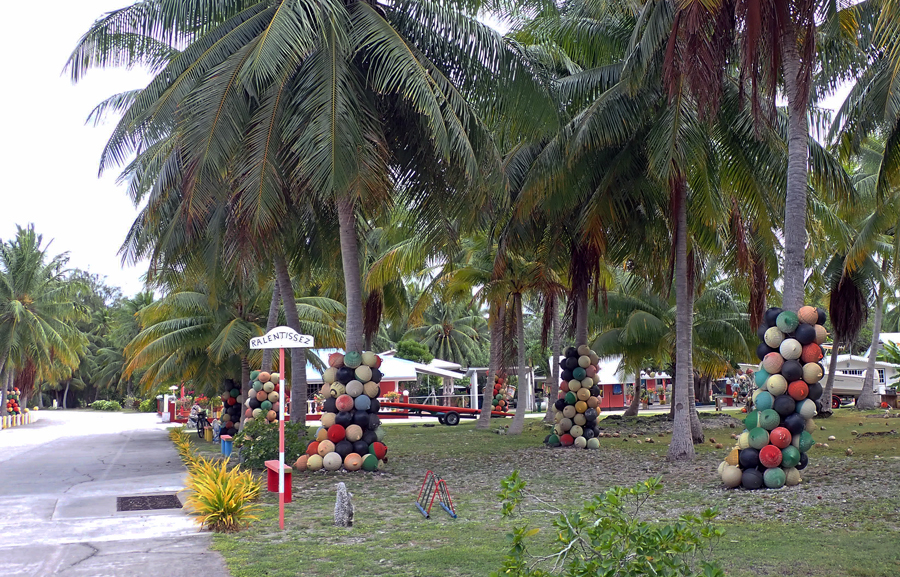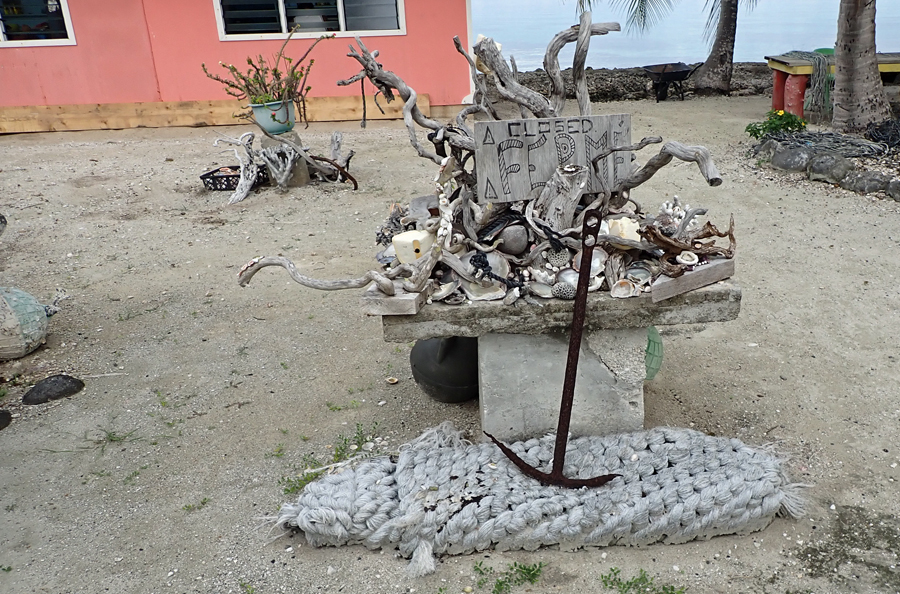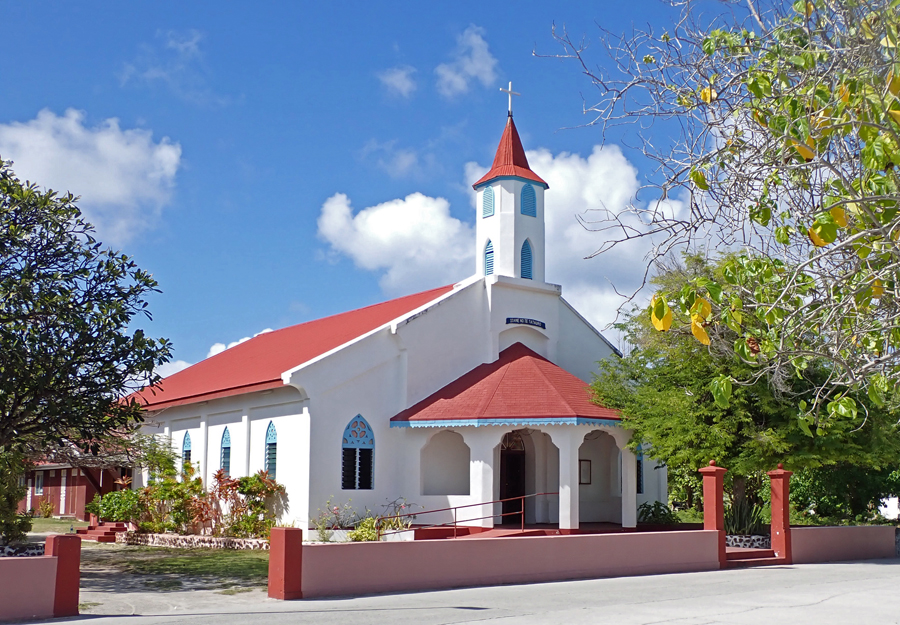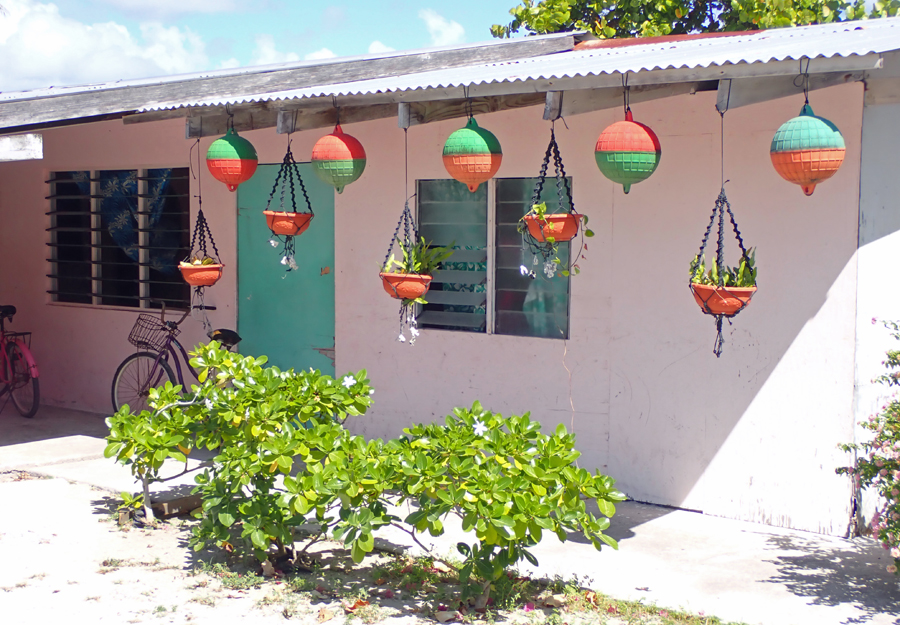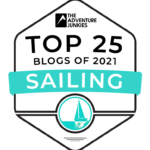To continue on with part three ( Part I – Part II):
Sailing inside an atoll
Yes, fuel is available in Fakarava. In fact, it couldn’t be easier. Once we dropped the anchor near the small village of Rotoava after dodging bommies and pearl farms on the way up, we could see the fuel pump near the dock. I’ll get back to fuel in the next section.
Our sail from the south of Fakarava was very enjoyable. It’s been a long time since we’ve sailed in protected waters. Most of our sailing now is out in blue water on the ocean. I miss the days of sailing on the leeward side of barrier islands such as the Caribbean or the Bahamas where the seas are relatively flat and gentle and sailing between islands is easy. When we were learning Cream Puff, most of our sailing was done in Tampa Bay. Sailing up this atoll reminded me of our good times in Tampa Bay.
Even though we are in protected waters, sailing inside an atoll can be a bit of a challenge. These French Polynesian atolls have bommies as I mentioned in Part II. Most of the atoll is uncharted. This means we have nothing to help us regarding the depths and hazards. However, there is a charted channel connecting the North and South Passes. But, this doesn’t mean the channel is free of bommies. It means they appear on our charts so we can avoid them. Keeping an eye on the water color in front of the boat in addition to the navigation screen also helps. The water color will change from a deep blue to light blue indicating shallow water. The bigger bommies have depths charted. The small ones just have an asterisk marking the location. It is important to keep zoomed in on the navigational screen so not to miss one of these asterisks.
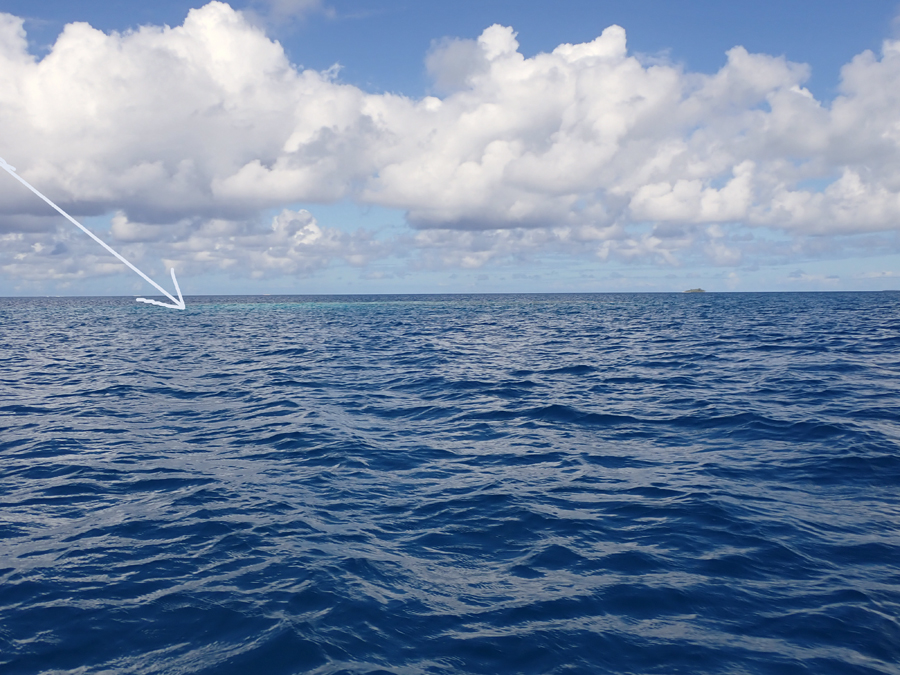
This is what a bommie looks like – light-colored water. The water goes from very deep to about 1 meter (3′) quickly. They are rocky and hazardous. A few break the surface but most lay just beneath.
I watched a boat sailing near us go right over a bommie. The water depth was charted as 5 meters (about 15’). I’m not sure if the skipper of that vessel had a huge amount of faith in his charts and accurate depths reported or if he just wasn’t paying attention. Or perhaps, the skipper had knowledge of the depths of this particular bommie. We stay away from bommies regardless of the depths reported on the charts. There’s plenty of room to go around since they are not very big.
Pearl farms are another headache. If you’ve ever visited or read about French Polynesia, you are familiar with the black pearls for which these islands are famous. The oysters are grown attached to a series of net cages. They are anchored to the seabed and often put out in a circle. The circle is marked with a series of floats. These floats are our only warning. The farms or the farming areas are not charted.
It’s possible to sail over the cages between the floats since they are quite deep. However, it is also possible to get a stray line wrapped about our propeller if we are motoring. We have line cutters on the propeller to minimize any damage to the boat. But sadly, we might destroy a portion of someone’s farm by cutting a cage loose. I would hate for that to happen. Fortunately, the wind was favorable and we were sailing with the engine off when we encountered a couple of farms. We passed over them with no issue. But, I’d be lying if I said there wasn’t a bit of an “oh crap” factor when we find ourselves surrounded by buoys indicating we are in the middle of a patch.
The farms we passed over were right in the middle of the rhumb line between the chartered channel and the village. I made a quick note on our electronic charts so we’d avoid the area in the future.
Fuel
As I mentioned, getting fuel was very easy. Our charts showed the water in front of the dock to be amply deep so we’d stay off the bottom. We need 2.1m (about 7’) to float. Standing on the dock and looking in the water it didn’t seem very deep. The water here is very clear and there’s an illusion of being shallow. The only way to be sure was to check for ourselves with our hand-held portable depth meter.
On a Sunday, when no boat traffic was at the dock, we took our meter and dinghy over to measure. I idled the dinghy along the path I planned to take Cream Puff and Cindy called off the water depth. We notice a couple of coral heads and also measured the depth directly over these to be sure they wouldn’t hinder our approach. The shallowest depth we recorded was right at the concrete wall of the dock, 3.2 meters (10.5’). The tide here is only a couple of feet so we were unconcerned about if the tide was in or out. Basically, we have plenty of water to bring in Cream Puff.
One of the really nice things French Polynesia does for us is allowing us to purchase tax-free fuel. As we are considered a vessel in transit for our 3 years in French Polynesia, our boat is exempt from taxation. In order to purchase tax-free fuel there is paperwork involved. And because the islands are French, there is a lot of paperwork involved. While in Pape’ete, Tahiti we let our paperwork expire. Quite frankly, I forgot all about it. Cindy remembered but for whatever reason, I dismissed the idea of renewing our status and discouraged her from renewing.
The savings on fuel is quite significant, about 33%. Multiply this by the fact our fuel tank would take on over 500 liters (130 US Gals), we had some motivation to get our act together with customs and have our tax-free fuel status reinstated. If you are a regular reader here, you already know who does the paperwork. It’s all Cindy. I just don’t have the patience. When we arrived in French Polynesia, we used an agent to help us with the arrival process. This is not a mandate but most certainly a great convenience. For a small fee, they handle all of our vessel and immigration paperwork. This is one of those times when having an agent paid off in dividends.
Cindy contacted our agent and explained to them we’d let our fuel certificate lapse. There are only a couple of places in French Polynesia where customs issues these certificates. Tahiti and Nuku Hiva are the only islands I’m aware of. Our agent is located on Tahiti. There were forms Cindy needed to complete and send to them via email. What we didn’t know was if the new certificate could be sent to us via email or would they need to mail an original.
The postal service, OPT is very efficient here. To mail something from one island to another is quite simple. It could be held at the local post office for us to pick up. If we should need to have the original document, it wouldn’t be a big deal but it would delay our ability to buy fuel for about another week. We still have a ¼ tank so we were not too worried. Besides, if needed we could always buy a few gallons to tie us over until we have our paperwork act together. We get good news from our agent. The whole process can be done over email and can be completed in two days. The fee is around US$60. Deal!
The fuel dock is a very clever setup. One side of the pump is for cars and motorcycles. The other side is for boats. I think this might be the only fuel pump on Fakarava. We have a choice of diesel or gasoline. In some of the older cruiser’s web postings about fueling here, there was talk of filling jerry cans at a Total gas station. We didn’t see a Total station. So, I’m guessing this is now the only setup. Two days prior to the supply ship arriving, the island ran out of gasoline. I didn’t see or hear of other sources. I just saw some frustrations as cars pulled up to the pump only to see the sign.
When we sent a picture of the Puffster taking on fuel to our friends in the USA, the first question everyone asked us was, “how much was it per gallon”. The USA is not used to high fuel prices like most of the world. And with the current inflation trend, they are seeing a national average price for gas over US$5 per US Gal (US$1.32 per liter). This is about 50% more than they are used to paying.
The total amount of fuel we took on was 504 liters (133 US Gal). The total tax-free price was 50,386 xpf. This equates to 133 US gallons for US$439.67 or US$3.31 per US Gal ($0.87/L). This price included the 33% discount to free us of taxes. Without the discount: US$4.33 per US Gal. This is amazing since we are in the middle of nowhere. Think about the distribution this fuel must take. I’m not sure of the fuel’s origin. It goes to Tahiti first on a tanker, then put onto a smaller supply ship. Then, unloaded to the local station. The price here is still lower than mainland USA. The fuel prices in French Polynesia are overseen by the FP government.
I’ve recently been reading from other cruisers about fuel prices in places like the Bahamas. Like French Polynesia, there is an island in the Bahamas that has the main port, New Providence. From there, fuel is sent to surrounding islands. Some cruisers have posted pictures of diesel prices upward of US$8 per gallon (US$2.11 per liter). Ouch. So glad we are cruising here and not there.
Supply Ship
I think the reason the gas ran out was because the supply ship was late and the previous ship was canceled. This is the way of life on these islands. Everything and I mean everything comes in on the supply boat. There is a small farm and chicken coop (for eggs). But there is certainly not enough to sustain the needs of the people living here. Yes, they could survive on fishing but who’d want to live solely on fish. I guess there is always the option of a coconut diet.
We timed our arrival to get diesel the day after the supply ship arrived. We were hoping to score some fresh vegetables and fruit in addition to fuel. But the pickings were slim. Many of the locals will preorder stock for the local shops or they will order from shops in Tahiti who put the items on the supply ship. This is especially true for fruits and vegetables. Otherwise, cruisers wipe out the store as they provision before heading to more deserted parts of the atoll for a few weeks. Prior to sailing to the Tuamotus, Cindy had read about how to preorder provisions. But since Cream Puff was still very well stocked we only needed a few items. It did not warrant ordering ahead. We got most of what we needed from the various stores in the village. As well as a few surprise items we did not think would be out here.
There is a single cash register in the store. And, on Thursday the line of people wishing to pay was quite long. When Cindy went in to pay for our fuel she picked up a couple of food items and joined the line. When she got to the front, there were a lot of forms to fill out for the tax-free fuel. When she told me about this and I could not help but think about life back in the USA. People would have groaned, complained and thrown their arms up in the air because someone is taking too long. People here are calm and patient. Not just because this is an island with not much going on. I noticed the same on Tahiti and how drivers very rarely honk at another car holding up traffic. I must say, I don’t miss those wound-tight people.
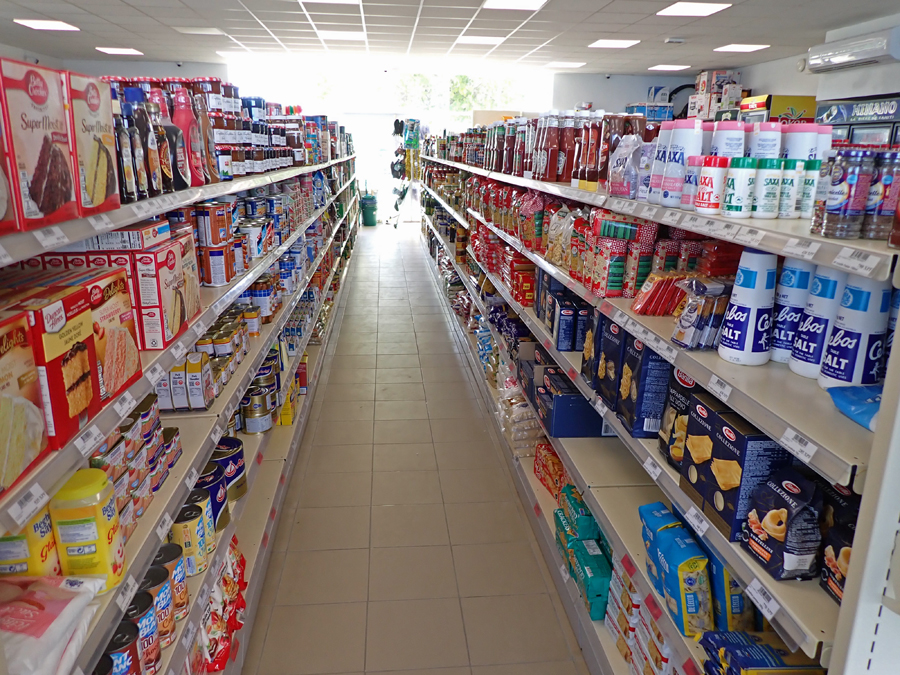
There are three food stores in the village. This is the largest and is a part of the fueling station. Very clean and well stocked (fresh stuff dependent on the supply ship schedule)
The arrival of the supply ship is a big event. In addition to food and fuel, people have all sorts of items shipped from Tahiti. The unloading of the ship takes place on the town dock, the same dock where we fuel or dock our dingy when ashore. The process reminded me of a baggage claim area of an airport.
The first thing unloaded from the ship are two forklift vehicles. These are used to unload the ship. A third forklift stays on the vessel and moves the cargo to a platform on the starboard (right) side of the ship. This platform allows the forklift on the dock to pick up the cargo and place it in a staging area. Once in the staging area, the recipients can dig through the metal cages placed by the forklift for their goodies. This is the part that reminded me of baggage claim. I think there was a makeshift desk with some receiving paperwork but I don’t think the locals paid much attention to any formalities. Once they spotted their stuff, they loaded it into a waiting vehicle and off they went.

The unloading begins. Someone got a new bicycle. Here you can see the metal crates that have packages for locals inside. Also visible is the platform on the side of the ship used to unload cargo.
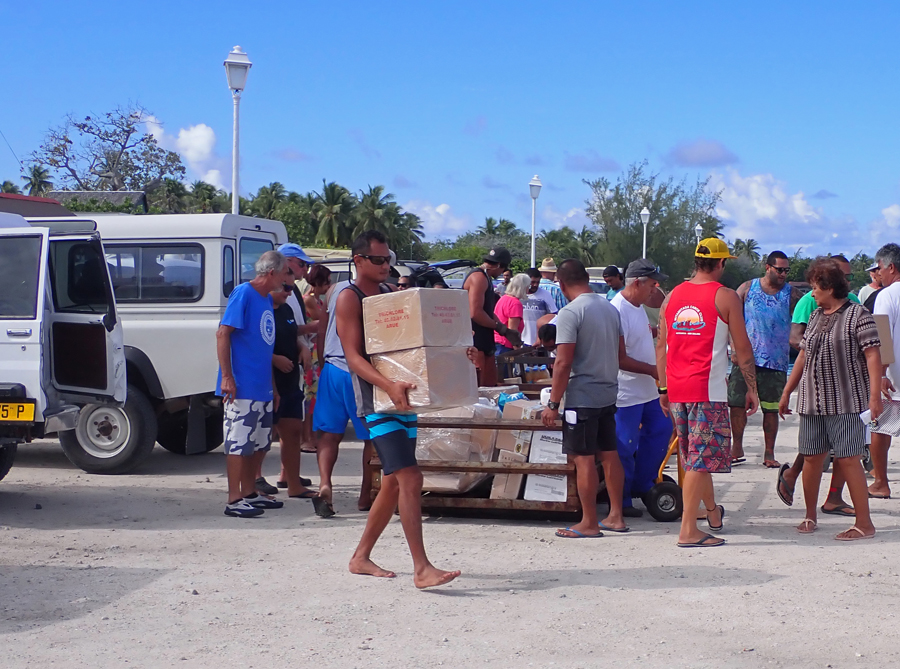
The metal crates are moved to an area of the pier away from the ship and people sort through looking for their long-awaited goodies.
Island Taxes and Trash
While in town, we took the opportunity to pay the tourist tax. This is done at the city hall housing the mayor’s office. There is an outside window with a cashier. We showed her on the calendar how long we’d been here and when we planned to leave. It isn’t very much money and the main benefit is substantial. It gives us a place to unload our trash. We have been on the boat at the lower end of the atoll for just over 4-weeks. Needless to say, we have some trash.
We are very disciplined at washing stuff before it goes into the trash bin to stop any smells. We are also human trash compactors making sure as much as possible goes into the waste bin under the kitchen sink. From there, after sealing up the bag, it is transferred to a large thick black plastic contractor bag. This is kept in one of the deck storage lockers. Hence all of the trash is eventually double-bagged to prevent odors and flies. For our first trash drop after the 4 weeks we’d been away from almost all civilization, we had about the equivalent of one household trash can to drop off.
It is a little bit frustrating that some of the cruisers don’t pay the fee. Recently the mayors of some islands have been cracking down and also raising the fee. I don’t think it is because cruisers are trying to cheat the government out of some money (some might be). I think it is because the awareness of these fees is not well known. On Fakarava, they have placed signs in multiple languages on beaches where cruisers anchor telling them to not dump or burn trash on the beach and to dispose of it in town after paying the tax.

A small clinic serves the health needs of the locals – most of their health care is free or very low cost. Pharmaceuticals arrive by plane with next-day delivery (in most cases). There is no pharmacy here.
The fee is really a pittance. It is US$10 per week for the boat. This is the trash fee. We only pay this fee when in town. The cashier did not collect for the entire time we’d been in the atoll. In all honestly, I would have paid more. The convenience of having a place to drop trash and a nice dinghy dock to land with clean ladders and cleats to tie off on – is priceless. The second tax is a tourist tax. I’m not sure what it covers for us but it is hardly a burden. It equates to about US$0.50 per day per person. Our total tax bill was less than US$100 for a two-month period.
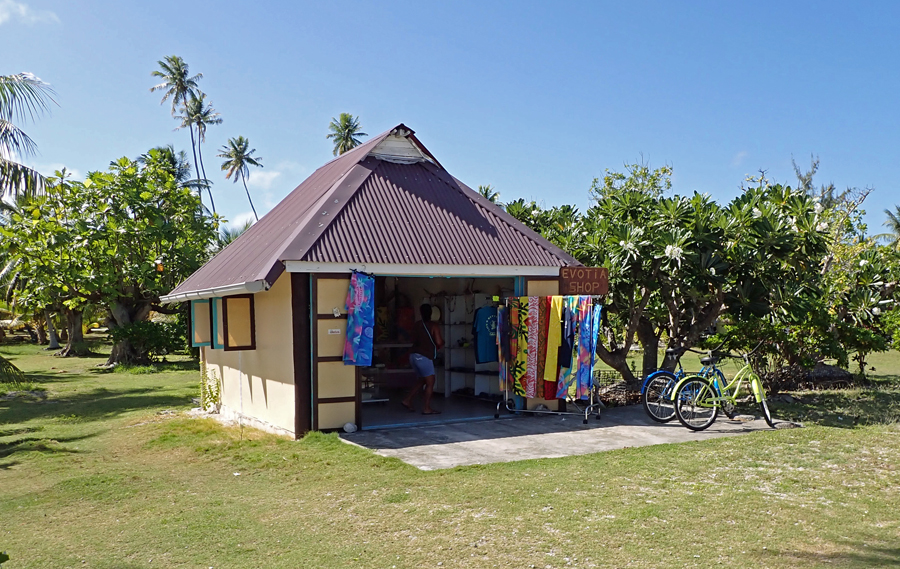
A gift shop where Cindy purchased a souvenir. How often do you get a chance to buy something with Fakarava written on it?
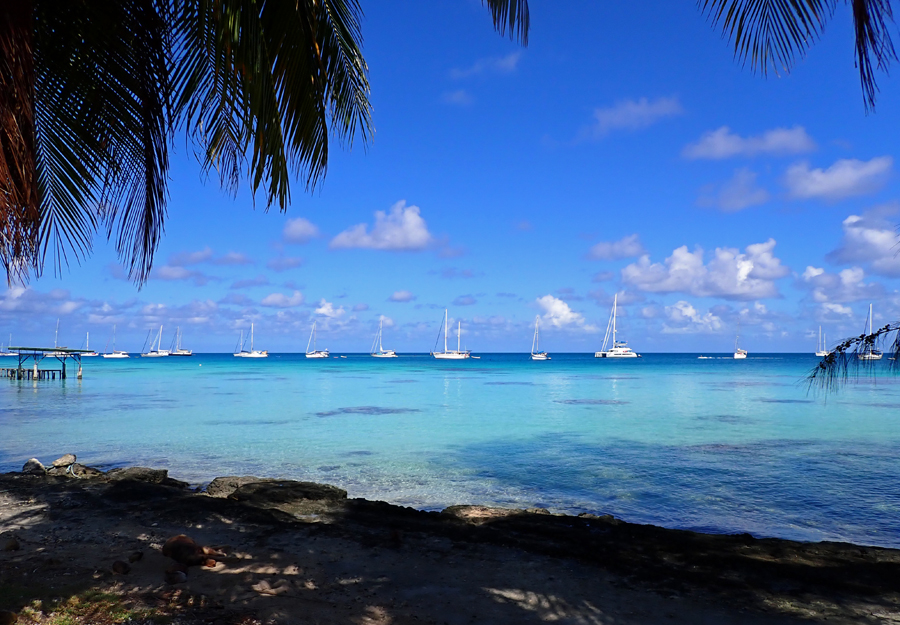
We are treated to fabulous vistas of the atoll interior as we walk down the road – about 35 boats anchored on this particular day.
On a bit of a funny note; when we arrived in town, this is the first time we’ve seen cars in over a month. There are not a lot of paved roads here and I’d imagine having a car is a pure luxury and most certainly not a necessity. Looking at Google maps, I estimate there is a total of about 40 km (25 miles) of roads here. Most of which are located in the small village of Rotoava. The village with its few shops is about 2 km from one end to the other. This atoll is flat. Meaning, a person could very well manage with a bicycle. I don’t imagine the person who sells automotive tires makes a lot of money.


